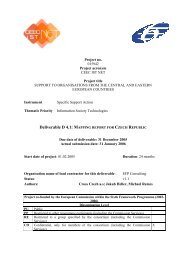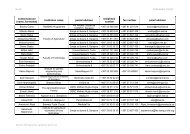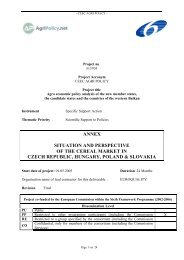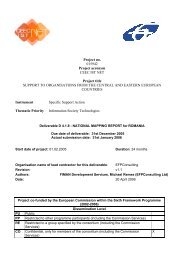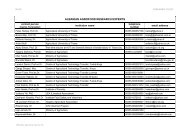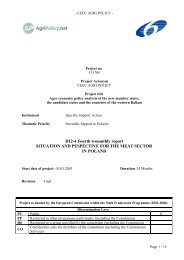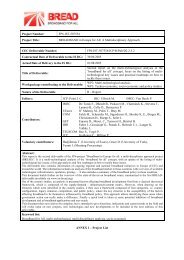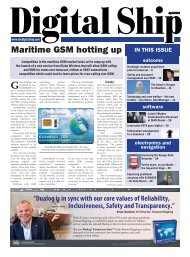Project Number: FP6-IST-507554 Project Title: BROADBAND in ...
Project Number: FP6-IST-507554 Project Title: BROADBAND in ...
Project Number: FP6-IST-507554 Project Title: BROADBAND in ...
Create successful ePaper yourself
Turn your PDF publications into a flip-book with our unique Google optimized e-Paper software.
Band Frequencies (kHz) Application<br />
A 9 to 95 Out of house transmission<br />
B 95 to 125 In house transmission<br />
Page 38 of 319<br />
<strong>FP6</strong>-<strong>IST</strong>-<strong>507554</strong>/JCP/R/Pub/D2.2-3.2<br />
C 125 to 140 In house transmission based on a specific multiple access protocol<br />
D 140 to 148.5 In house transmission<br />
E From 150 Radio bands, …<br />
Table 4: CENELEC Bands for Data Transmission over 230/400 V Power L<strong>in</strong>e Networks<br />
(transmitter power ≤ 5 mW)<br />
7.2.1.4.1 Frequency allocations<br />
ETSI and CENELEC have partitioned the HF frequency band (from 1.8 MHz to 30 MHz) <strong>in</strong>to two parts:<br />
• from 1.8 MHz to 12 MHz is allocated for Access PLC<br />
• from 12 MHz to 30 MHz is allocated for In-House PLC<br />
7.2.1.4.2 <strong>Project</strong>s<br />
The 2 ma<strong>in</strong> European projects cover<strong>in</strong>g PLC are:<br />
• <strong>FP6</strong> project: OPERA: cover<strong>in</strong>g all the aspects of PLC<br />
• FP5 project: 6power: cover<strong>in</strong>g Ipv6, QoS & POWER l<strong>in</strong>e <strong>in</strong>tegration (concluded)<br />
More detailed description of these projects is given <strong>in</strong> Annex.<br />
7.2.1.5 Issues and trends<br />
There are some recent publications, which demonstrates that <strong>in</strong>herent problems can be solved by adopt<strong>in</strong>g new<br />
modulation technologies such as multi-carrier modulation (MCM) and of use digital filter banks (DFB) <strong>in</strong>stead<br />
of OFDM to obta<strong>in</strong> high level stop-band attenuation (larger than 100 dB) to ensure that the technology do not<br />
have a power leakage <strong>in</strong> the frequency bands allocated to other users of the HF band. This new technology, uses<br />
peer to peer communications <strong>in</strong>stead of the commonly used master-slave communications to keep the<br />
electromagnetic radiations as low as possible. The MAC (medium access control) allows ad hoc network<strong>in</strong>g and<br />
self-organization. The results of computer simulations have shown that this new technology can meet NB30<br />
requirements under normal operations. High data rates (up to 300 Mbps) both <strong>in</strong>teractive (IP services) and<br />
broadcast (DTV) services can be offered.<br />
The ma<strong>in</strong> PLC players (those that have known customers and whose technology has been proven <strong>in</strong> the field)<br />
are:<br />
• Ascom: It is based on a 2 Mbps GMSK technology. Ascom develops both the core technology and the<br />
equipment. The used frequency bands are compatible with European standards. However, Ascom is no<br />
more active <strong>in</strong> the commercial field.<br />
• DS2: 1280-carriers OFDM technology can provide up to 45 Mbps <strong>in</strong> a 10-MHz range. DS2 targets<br />
both access and home network<strong>in</strong>g markets. Its frequency allocation is compatible with European<br />
standards. They have announced a new generation of PLC equipment hav<strong>in</strong>g up to 200 Mb/s, but the<br />
technology is not yet proven <strong>in</strong> the field. DS2 equipment does not meet the CENELEC and NB30<br />
standards with respect to radiations and <strong>in</strong>terference.<br />
• Intellon: the HomePlug standard is based on their technology (84-carriers OFDM, 14 Mbps theoretical<br />
data rate, 6-8 Mbps actual data rate). Intellon is exclusively focused on the home network<strong>in</strong>g market<br />
(it’s technology does not support repeaters, which precludes it from be<strong>in</strong>g used <strong>in</strong> long-distance access<br />
scenarios). It’s <strong>in</strong>efficient frequency allocation (from 4 to 20 MHz) is <strong>in</strong>compatible with European<br />
standard regard<strong>in</strong>g access and <strong>in</strong>-home coexistence.<br />
• Itran: 2 Mbps CDMA technology. It is not compatible with European standard regard<strong>in</strong>g coexistence<br />
between access and <strong>in</strong>-home. Its ma<strong>in</strong> customer is the Israeli company Ma<strong>in</strong>net.



